International Marketing Market Entry Modes and Expansion Strategies

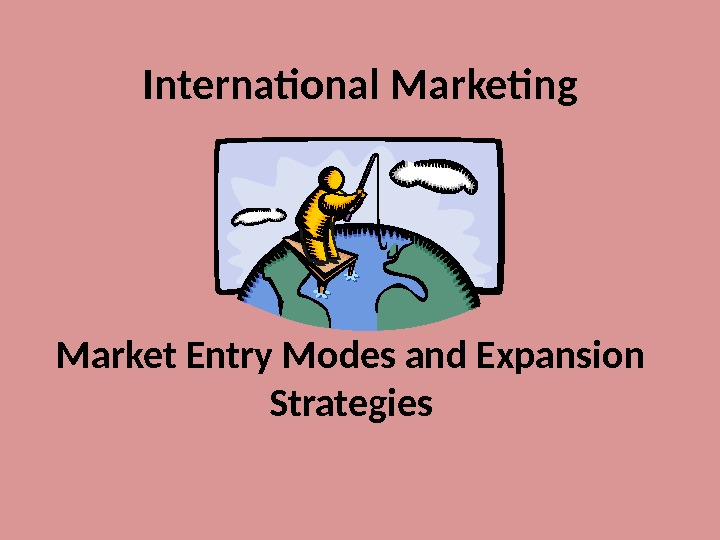
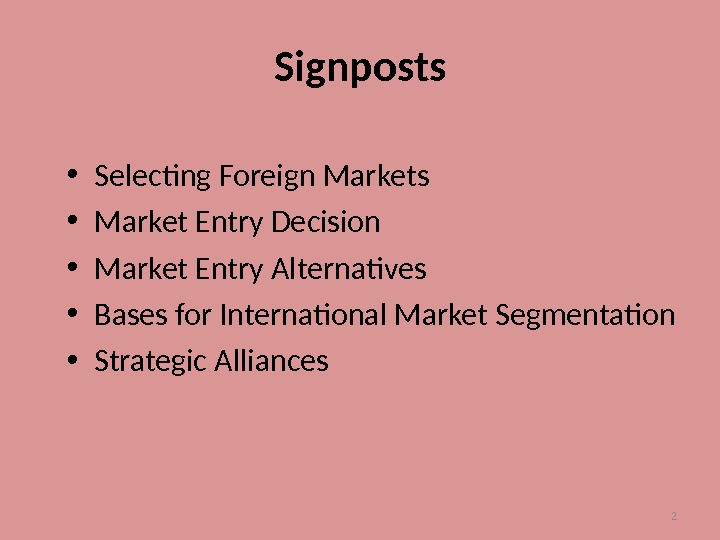

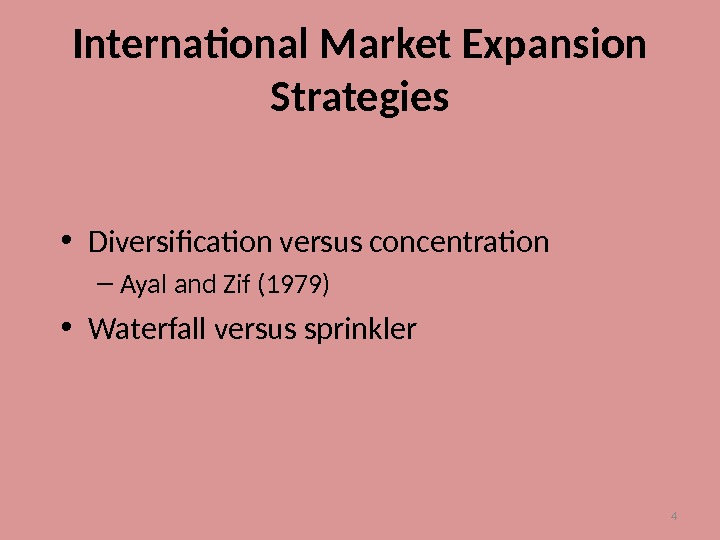
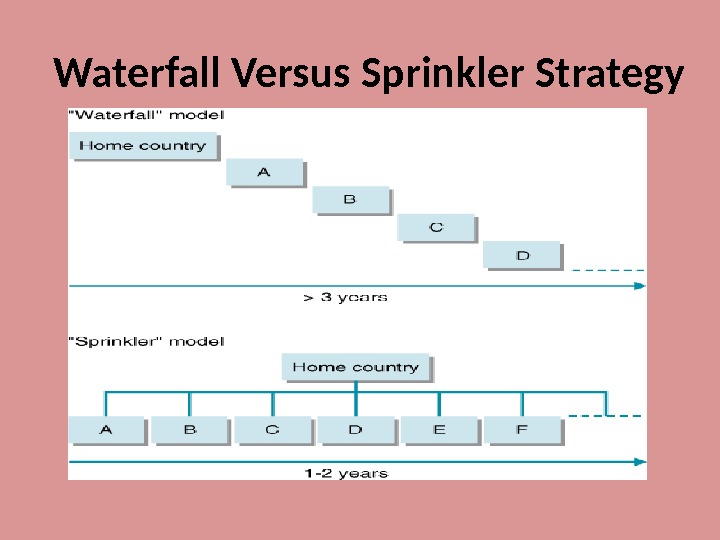
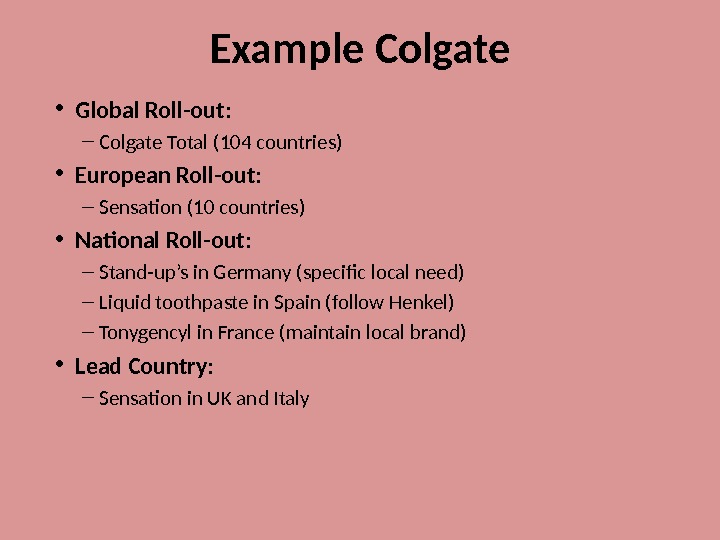

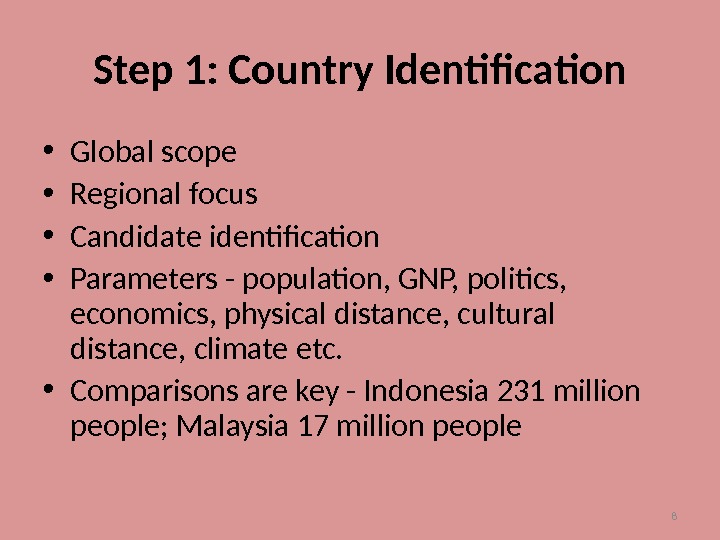
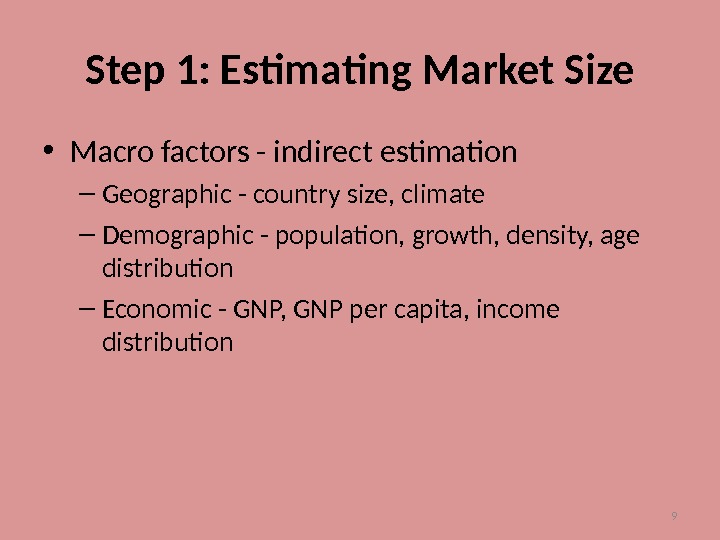
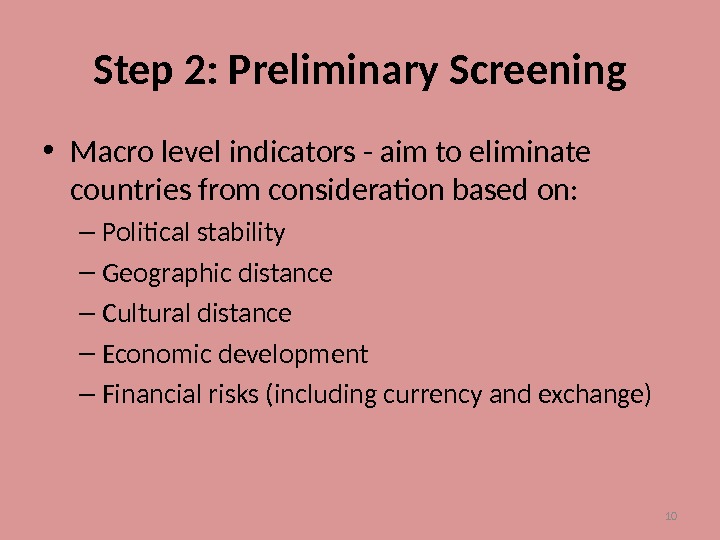



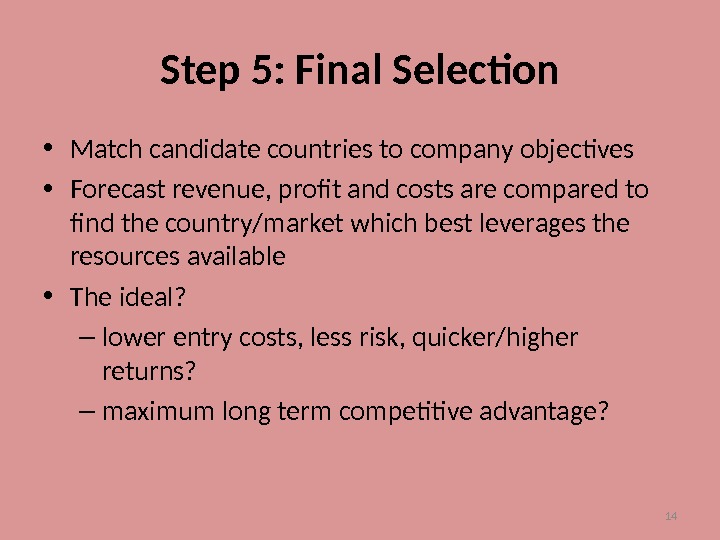
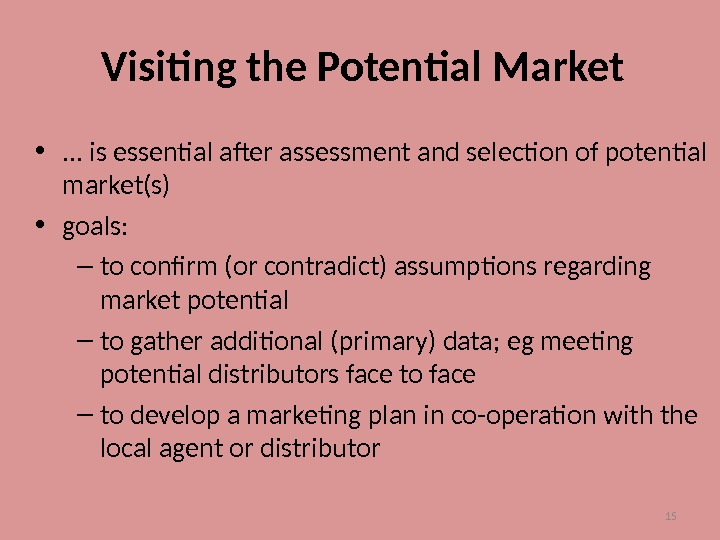

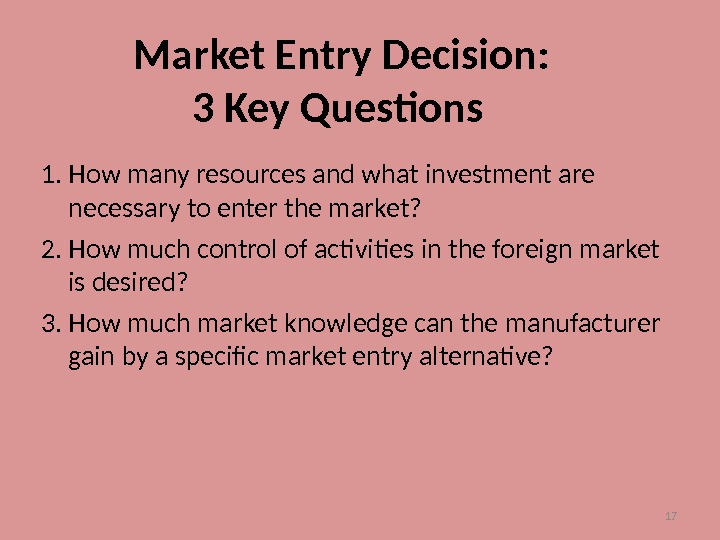
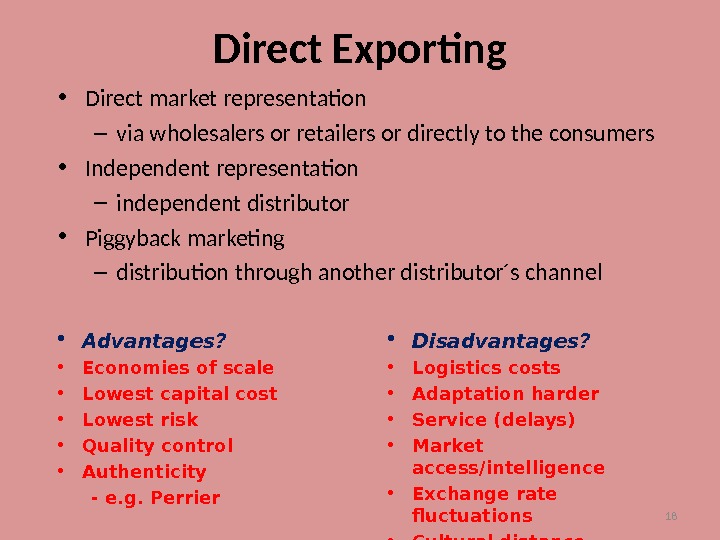
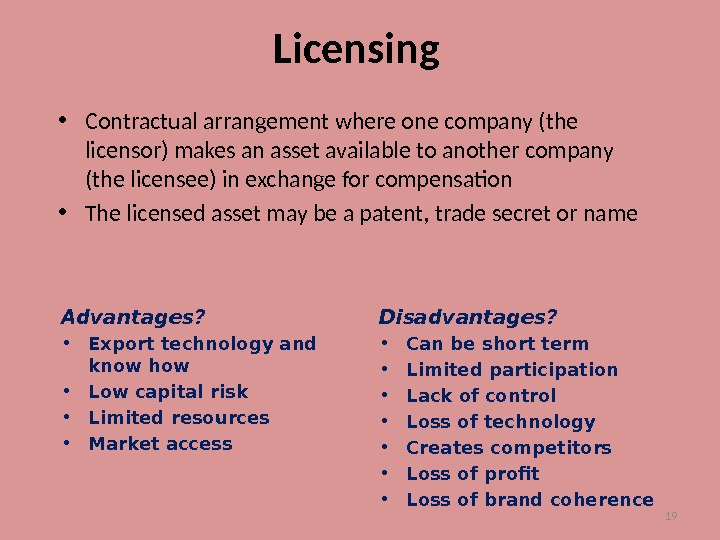

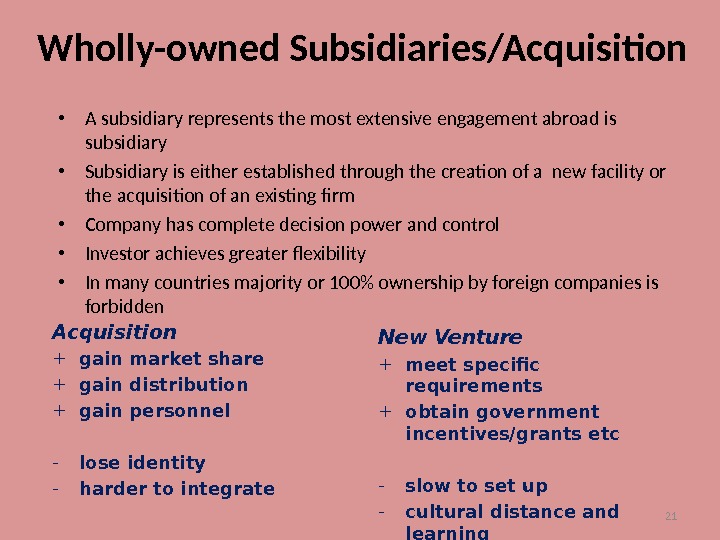
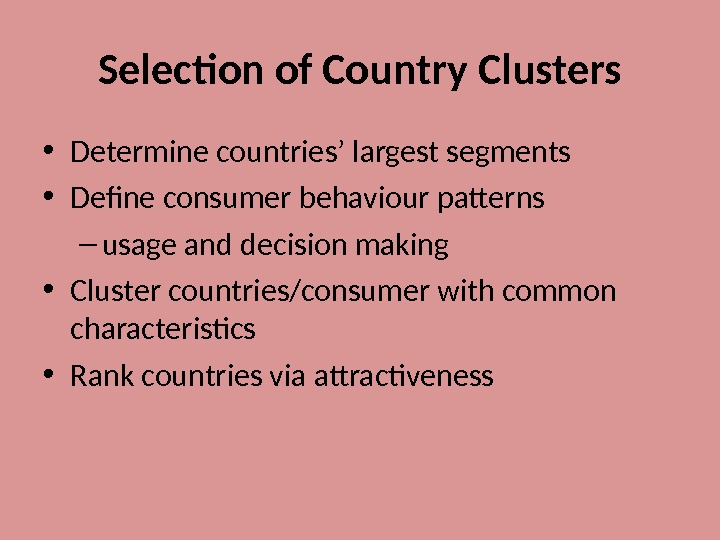
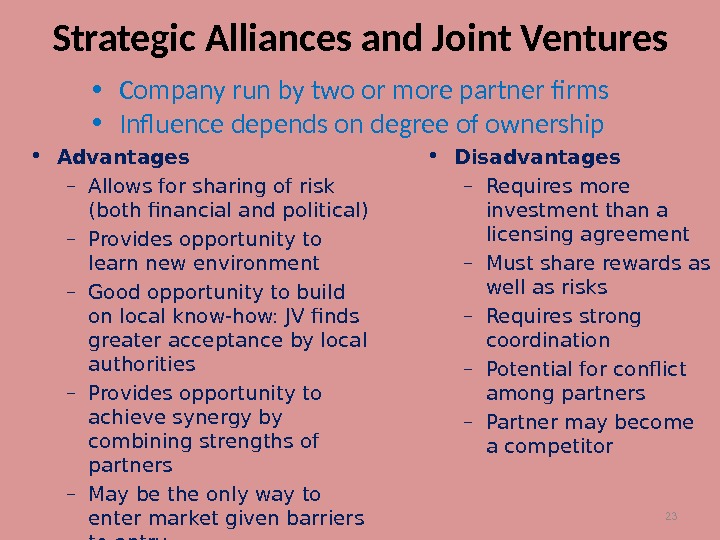

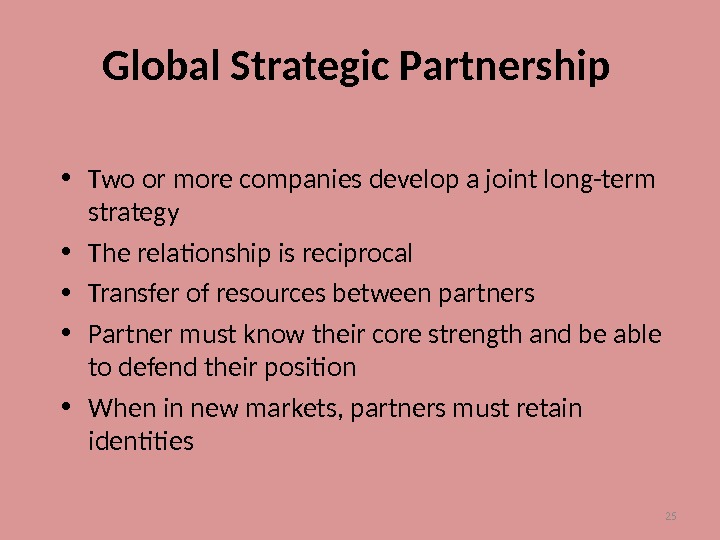
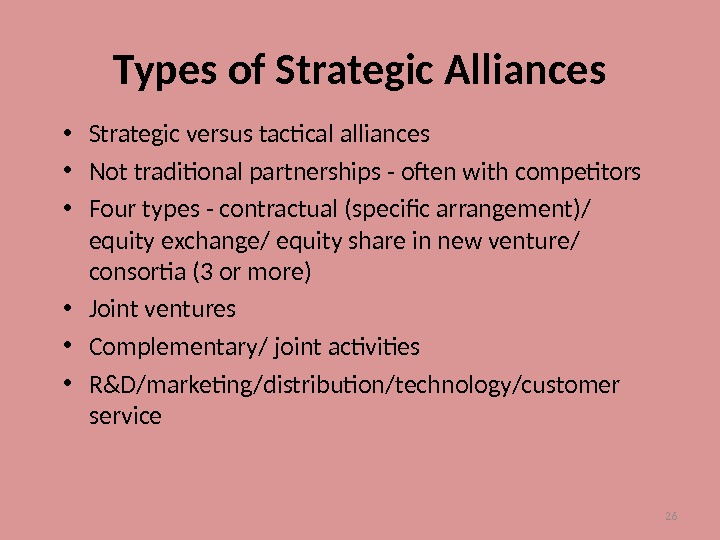

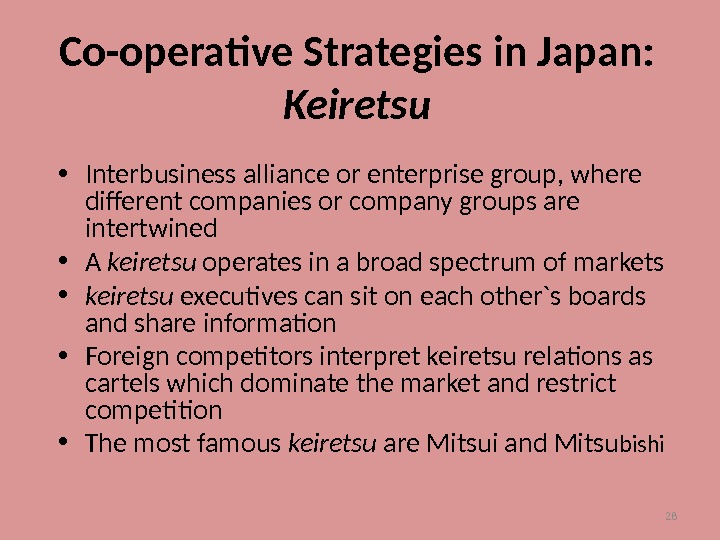
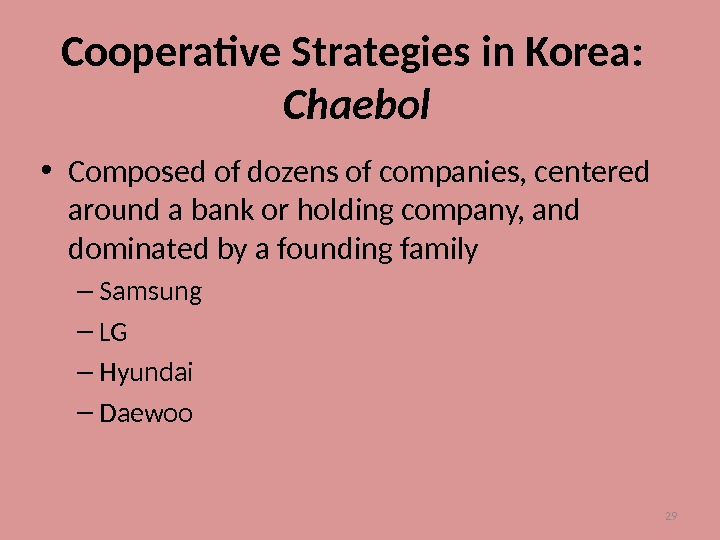
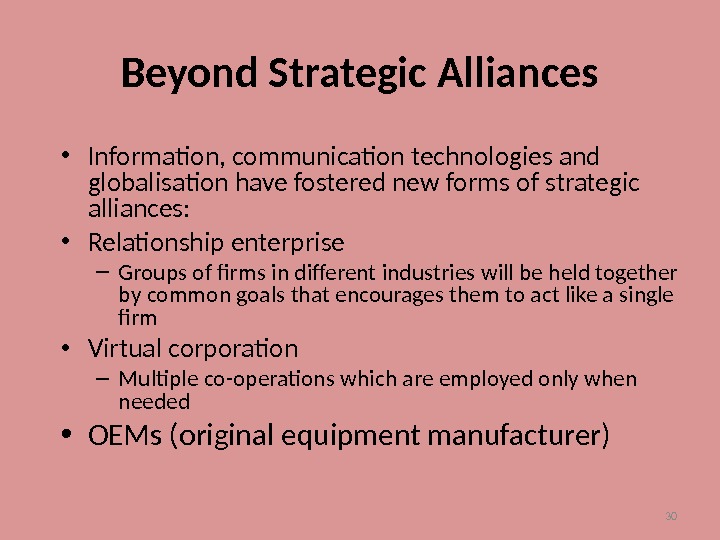
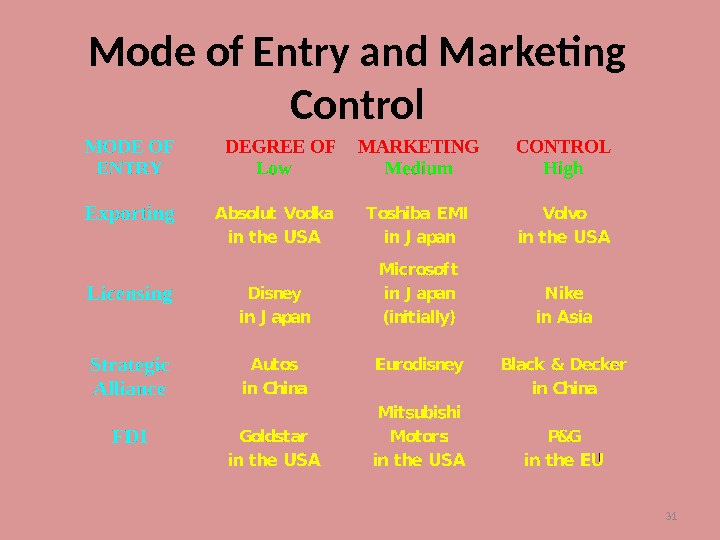
international_market_entry.ppt
- Размер: 314 Кб
- Количество слайдов: 31
Описание презентации International Marketing Market Entry Modes and Expansion Strategies по слайдам
 International Marketing Market Entry Modes and Expansion Strategies
International Marketing Market Entry Modes and Expansion Strategies
 2 Signposts • Selecting Foreign Markets • Market Entry Decision • Market Entry Alternatives • Bases for International Market Segmentation • Strategic Alliances
2 Signposts • Selecting Foreign Markets • Market Entry Decision • Market Entry Alternatives • Bases for International Market Segmentation • Strategic Alliances
 3 Critical Questions for a Product-Market Profile: The 9 W´s 1. Who buys our product? 2. Who does not buy our product? 3. What need or function does our product serve? 4. What problem does our product solve? 5. What are customers currently buying to satisfy the need and/or solve the problem for which our product is targeted? 6. What price are they paying for the products they are currently buying? 7. When is our product purchased? 8. Where is our product purchased? 9. Why is our product purchased?
3 Critical Questions for a Product-Market Profile: The 9 W´s 1. Who buys our product? 2. Who does not buy our product? 3. What need or function does our product serve? 4. What problem does our product solve? 5. What are customers currently buying to satisfy the need and/or solve the problem for which our product is targeted? 6. What price are they paying for the products they are currently buying? 7. When is our product purchased? 8. Where is our product purchased? 9. Why is our product purchased?
 4 International Market Expansion Strategies • Diversification versus concentration – Ayal and Zif (1979) • Waterfall versus sprinkler
4 International Market Expansion Strategies • Diversification versus concentration – Ayal and Zif (1979) • Waterfall versus sprinkler
 Waterfall Versus Sprinkler Strategy
Waterfall Versus Sprinkler Strategy
 Example Colgate • Global Roll-out : – Colgate Total (104 countries) • European Roll-out : – Sensation (10 countries) • National Roll-out : – Stand-up’s in Germany (specific local need) – Liquid toothpaste in Spain (follow Henkel) – Tonygencyl in France (maintain local brand) • Lead Country : – Sensation in UK and Italy
Example Colgate • Global Roll-out : – Colgate Total (104 countries) • European Roll-out : – Sensation (10 countries) • National Roll-out : – Stand-up’s in Germany (specific local need) – Liquid toothpaste in Spain (follow Henkel) – Tonygencyl in France (maintain local brand) • Lead Country : – Sensation in UK and Italy
 7 Opportunity Analysis: 5 Step Process • Step 1: Identification of candidate countries • Step 2: Preliminary screening • Step 3: In-depth screening • Step 4: In-country visits • Step 5: Final selection
7 Opportunity Analysis: 5 Step Process • Step 1: Identification of candidate countries • Step 2: Preliminary screening • Step 3: In-depth screening • Step 4: In-country visits • Step 5: Final selection
 8 Step 1: Country Identification • Global scope • Regional focus • Candidate identification • Parameters — population, GNP, politics, economics, physical distance, cultural distance, climate etc. • Comparisons are key — Indonesia 231 million people; Malaysia 17 million people
8 Step 1: Country Identification • Global scope • Regional focus • Candidate identification • Parameters — population, GNP, politics, economics, physical distance, cultural distance, climate etc. • Comparisons are key — Indonesia 231 million people; Malaysia 17 million people
 9 Step 1: Estimating Market Size • Macro factors — indirect estimation – Geographic — country size, climate – Demographic — population, growth, density, age distribution – Economic — GNP, GNP per capita, income distribution
9 Step 1: Estimating Market Size • Macro factors — indirect estimation – Geographic — country size, climate – Demographic — population, growth, density, age distribution – Economic — GNP, GNP per capita, income distribution
 10 Step 2: Preliminary Screening • Macro level indicators — aim to eliminate countries from consideration based on: – Political stability – Geographic distance – Cultural distance – Economic development – Financial risks (including currency and exchange)
10 Step 2: Preliminary Screening • Macro level indicators — aim to eliminate countries from consideration based on: – Political stability – Geographic distance – Cultural distance – Economic development – Financial risks (including currency and exchange)
 11 Step 2: Preliminary Screening • Macro level anticipated costs: – Costs of entry matched to financial and other resource constraints – Transportation costs – Customs/tariffs/duties – Storage/warehousing – Distribution in country – Supporting products in the market
11 Step 2: Preliminary Screening • Macro level anticipated costs: – Costs of entry matched to financial and other resource constraints – Transportation costs – Customs/tariffs/duties – Storage/warehousing – Distribution in country – Supporting products in the market
 12 Step 3: In-depth Screening • The core of the opportunity evaluation • Data collection at industry, market and (ideally) segment level • Key criteria: – Market size – Market growth and potential – Competitive intensity, competitors’ strengths and weaknesses – Trade barriers • tariffs, taxes, duties
12 Step 3: In-depth Screening • The core of the opportunity evaluation • Data collection at industry, market and (ideally) segment level • Key criteria: – Market size – Market growth and potential – Competitive intensity, competitors’ strengths and weaknesses – Trade barriers • tariffs, taxes, duties
 13 Step 4: In-country Visits • Direct experience: – on the spot information – hands-on evaluation • Essential for measuring qualitative criteria, eg cultural factors • Key in determining relative weight of evaluation criteria
13 Step 4: In-country Visits • Direct experience: – on the spot information – hands-on evaluation • Essential for measuring qualitative criteria, eg cultural factors • Key in determining relative weight of evaluation criteria
 14 Step 5: Final Selection • Match candidate countries to company objectives • Forecast revenue, profit and costs are compared to find the country/market which best leverages the resources available • The ideal? – lower entry costs, less risk, quicker/higher returns? – maximum long term competitive advantage?
14 Step 5: Final Selection • Match candidate countries to company objectives • Forecast revenue, profit and costs are compared to find the country/market which best leverages the resources available • The ideal? – lower entry costs, less risk, quicker/higher returns? – maximum long term competitive advantage?
 15 Visiting the Potential Market • . . . is essential after assessment and selection of potential market(s) • goals: – to confirm (or contradict) assumptions regarding market potential – to gather additional (primary) data; eg meeting potential distributors face to face – to develop a marketing plan in co-operation with the local agent or distributor
15 Visiting the Potential Market • . . . is essential after assessment and selection of potential market(s) • goals: – to confirm (or contradict) assumptions regarding market potential – to gather additional (primary) data; eg meeting potential distributors face to face – to develop a marketing plan in co-operation with the local agent or distributor
 16 Market Entry Alternatives. Resource Deployment C ontrol and Foreign M arket Presence Indirect Exporting Direct Exporting Licensing Franchising Joint Ventures Acquisition/ Wholly-Owned Subsidiary Production in the Home Market Production Abroad lowhigh low high Source: Adapted from Günther Müller-Stewens and Christoph Lechner, ”Unternehmensindividuelle und gastlandbezogene Einflußfaktoren der Markteintrittsformen, ” in: Klaus Macharzina and Michael-Jörg Oesterle (eds. ), Handbuch Internationales Management, Gabler, Wiesbaden, 1997, p. 237; Gunter Stahr, Auslandsmarketing, Vol. 1, Kohlhammer, Stuttgart, 1979, p.
16 Market Entry Alternatives. Resource Deployment C ontrol and Foreign M arket Presence Indirect Exporting Direct Exporting Licensing Franchising Joint Ventures Acquisition/ Wholly-Owned Subsidiary Production in the Home Market Production Abroad lowhigh low high Source: Adapted from Günther Müller-Stewens and Christoph Lechner, ”Unternehmensindividuelle und gastlandbezogene Einflußfaktoren der Markteintrittsformen, ” in: Klaus Macharzina and Michael-Jörg Oesterle (eds. ), Handbuch Internationales Management, Gabler, Wiesbaden, 1997, p. 237; Gunter Stahr, Auslandsmarketing, Vol. 1, Kohlhammer, Stuttgart, 1979, p.
 17 Market Entry Decision: 3 Key Questions 1. How many resources and what investment are necessary to enter the market? 2. How much control of activities in the foreign market is desired? 3. How much market knowledge can the manufacturer gain by a specific market entry alternative?
17 Market Entry Decision: 3 Key Questions 1. How many resources and what investment are necessary to enter the market? 2. How much control of activities in the foreign market is desired? 3. How much market knowledge can the manufacturer gain by a specific market entry alternative?
 18 Direct Exporting • Direct market representation – via wholesalers or retailers or directly to the consumers • Independent representation – independent distributor • Piggyback marketing – distribution through another distributor´s channel • Advantages? • Economies of scale • Lowest capital cost • Lowest risk • Quality control • Authenticity — e. g. Perrier • Disadvantages? • Logistics costs • Adaptation harder • Service (delays) • Market access/intelligence • Exchange rate fluctuations • Cultural distance
18 Direct Exporting • Direct market representation – via wholesalers or retailers or directly to the consumers • Independent representation – independent distributor • Piggyback marketing – distribution through another distributor´s channel • Advantages? • Economies of scale • Lowest capital cost • Lowest risk • Quality control • Authenticity — e. g. Perrier • Disadvantages? • Logistics costs • Adaptation harder • Service (delays) • Market access/intelligence • Exchange rate fluctuations • Cultural distance
 19 Licensing • Contractual arrangement where one company (the licensor) makes an asset available to another company (the licensee) in exchange for compensation • The licensed asset may be a patent, trade secret or name Advantages? • Export technology and know how • Low capital risk • Limited resources • Market access Disadvantages? • Can be short term • Limited participation • Lack of control • Loss of technology • Creates competitors • Loss of profit • Loss of brand coherence
19 Licensing • Contractual arrangement where one company (the licensor) makes an asset available to another company (the licensee) in exchange for compensation • The licensed asset may be a patent, trade secret or name Advantages? • Export technology and know how • Low capital risk • Limited resources • Market access Disadvantages? • Can be short term • Limited participation • Lack of control • Loss of technology • Creates competitors • Loss of profit • Loss of brand coherence
 20 Franchising • Franchising is a special form of licensing • Franchisor is provided with an entire business concept (product and marketing package, managerial know-how) • Franchisor has extensive influence on the franchisee`s operations, but commits few financial resources • Internationally uniform brand image Advantages? • To franchisor — rapid expansion/ minimum capital and resources • To franchisee — high success rate/ capital available/ proven method/ brand/ product training/ management support Disadvantages? • To franchisor — quality control/ risk to brand/ loss of profit • To franchisee — cost/ control
20 Franchising • Franchising is a special form of licensing • Franchisor is provided with an entire business concept (product and marketing package, managerial know-how) • Franchisor has extensive influence on the franchisee`s operations, but commits few financial resources • Internationally uniform brand image Advantages? • To franchisor — rapid expansion/ minimum capital and resources • To franchisee — high success rate/ capital available/ proven method/ brand/ product training/ management support Disadvantages? • To franchisor — quality control/ risk to brand/ loss of profit • To franchisee — cost/ control
 21 Wholly-owned Subsidiaries/Acquisition • A subsidiary represents the most extensive engagement abroad is subsidiary • Subsidiary is either established through the creation of a new facility or the acquisition of an existing firm • Company has complete decision power and control • Investor achieves greater flexibility • In many countries majority or 100% ownership by foreign companies is forbidden Acquisition + gain market share + gain distribution + gain personnel — lose identity — harder to integrate New Venture + meet specific requirements + obtain government incentives/grants etc — slow to set up — cultural distance and learning
21 Wholly-owned Subsidiaries/Acquisition • A subsidiary represents the most extensive engagement abroad is subsidiary • Subsidiary is either established through the creation of a new facility or the acquisition of an existing firm • Company has complete decision power and control • Investor achieves greater flexibility • In many countries majority or 100% ownership by foreign companies is forbidden Acquisition + gain market share + gain distribution + gain personnel — lose identity — harder to integrate New Venture + meet specific requirements + obtain government incentives/grants etc — slow to set up — cultural distance and learning
 Selection of Country Clusters • Determine countries’ largest segments • Define consumer behaviour patterns – usage and decision making • Cluster countries/consumer with common characteristics • Rank countries via attractiveness
Selection of Country Clusters • Determine countries’ largest segments • Define consumer behaviour patterns – usage and decision making • Cluster countries/consumer with common characteristics • Rank countries via attractiveness
 23 Strategic Alliances and Joint Ventures • Company run by two or more partner firms • Influence depends on degree of ownership • Advantages – Allows for sharing of risk (both financial and political) – Provides opportunity to learn new environment – Good opportunity to build on local know-how: JV finds greater acceptance by local authorities – Provides opportunity to achieve synergy by combining strengths of partners – May be the only way to enter market given barriers to entry • Disadvantages – Requires more investment than a licensing agreement – Must share rewards as well as risks – Requires strong coordination – Potential for conflict among partners – Partner may become a competitor
23 Strategic Alliances and Joint Ventures • Company run by two or more partner firms • Influence depends on degree of ownership • Advantages – Allows for sharing of risk (both financial and political) – Provides opportunity to learn new environment – Good opportunity to build on local know-how: JV finds greater acceptance by local authorities – Provides opportunity to achieve synergy by combining strengths of partners – May be the only way to enter market given barriers to entry • Disadvantages – Requires more investment than a licensing agreement – Must share rewards as well as risks – Requires strong coordination – Potential for conflict among partners – Partner may become a competitor
 24 Demands on Strategic Alliances • Competitive collaborations that offer significant advantages • Characteristics: – Participants remain independent following to the formation of the alliance – Participants share the benefits of the alliance as well as control over the performance of assigned tasks – Participants make ongoing contributions in technology, products and other key strategic areas
24 Demands on Strategic Alliances • Competitive collaborations that offer significant advantages • Characteristics: – Participants remain independent following to the formation of the alliance – Participants share the benefits of the alliance as well as control over the performance of assigned tasks – Participants make ongoing contributions in technology, products and other key strategic areas
 25 Global Strategic Partnership • Two or more companies develop a joint long-term strategy • The relationship is reciprocal • Transfer of resources between partners • Partner must know their core strength and be able to defend their position • When in new markets, partners must retain identities
25 Global Strategic Partnership • Two or more companies develop a joint long-term strategy • The relationship is reciprocal • Transfer of resources between partners • Partner must know their core strength and be able to defend their position • When in new markets, partners must retain identities
 26 Types of Strategic Alliances • Strategic versus tactical alliances • Not traditional partnerships — often with competitors • Four types — contractual (specific arrangement)/ equity exchange/ equity share in new venture/ consortia (3 or more) • Joint ventures • Complementary/ joint activities • R&D/marketing/distribution/technology/customer service
26 Types of Strategic Alliances • Strategic versus tactical alliances • Not traditional partnerships — often with competitors • Four types — contractual (specific arrangement)/ equity exchange/ equity share in new venture/ consortia (3 or more) • Joint ventures • Complementary/ joint activities • R&D/marketing/distribution/technology/customer service
 27 Success Factors of Alliances • Mission • Strategy • Governance • Culture • Organisation • Management
27 Success Factors of Alliances • Mission • Strategy • Governance • Culture • Organisation • Management
 28 Co-operative Strategies in Japan: Keiretsu • Interbusiness alliance or enterprise group, where different companies or company groups are intertwined • A keiretsu operates in a broad spectrum of markets • keiretsu executives can sit on each other`s boards and share information • Foreign competitors interpret keiretsu relations as cartels which dominate the market and restrict competition • The most famous keiretsu are Mitsui and Mitsu bishi
28 Co-operative Strategies in Japan: Keiretsu • Interbusiness alliance or enterprise group, where different companies or company groups are intertwined • A keiretsu operates in a broad spectrum of markets • keiretsu executives can sit on each other`s boards and share information • Foreign competitors interpret keiretsu relations as cartels which dominate the market and restrict competition • The most famous keiretsu are Mitsui and Mitsu bishi
 29 Cooperative Strategies in Korea: Chaebol • Composed of dozens of companies, centered around a bank or holding company, and dominated by a founding family – Samsung – LG – Hyundai – Daewoo
29 Cooperative Strategies in Korea: Chaebol • Composed of dozens of companies, centered around a bank or holding company, and dominated by a founding family – Samsung – LG – Hyundai – Daewoo
 30 Beyond Strategic Alliances • Information, communication technologies and globalisation have fostered new forms of strategic alliances: • Relationship enterprise – Groups of firms in different industries will be held together by common goals that encourages them to act like a single firm • Virtual corporation – Multiple co-operations which are employed only when needed • OEMs (original equipment manufacturer)
30 Beyond Strategic Alliances • Information, communication technologies and globalisation have fostered new forms of strategic alliances: • Relationship enterprise – Groups of firms in different industries will be held together by common goals that encourages them to act like a single firm • Virtual corporation – Multiple co-operations which are employed only when needed • OEMs (original equipment manufacturer)
 31 Mode of Entry and Marketing Control
31 Mode of Entry and Marketing Control

